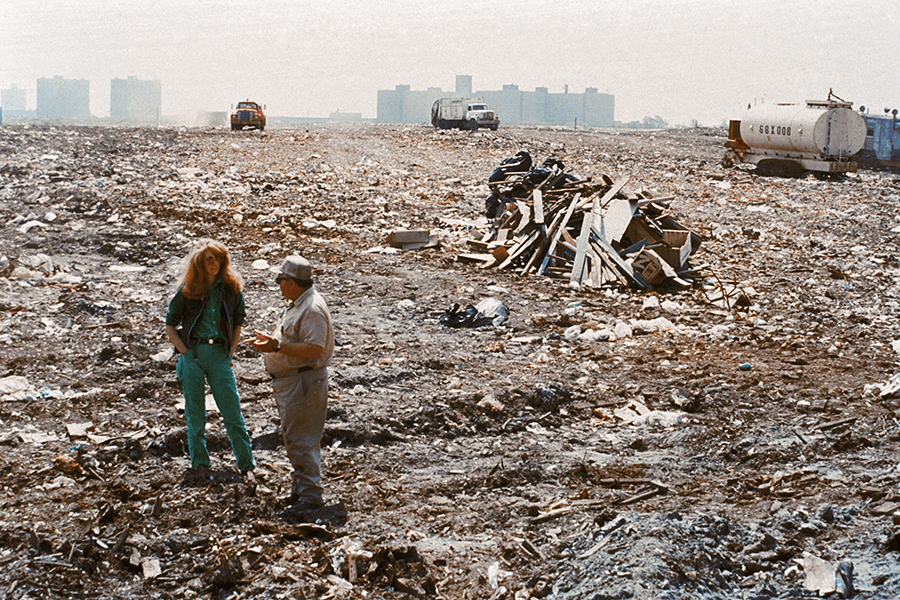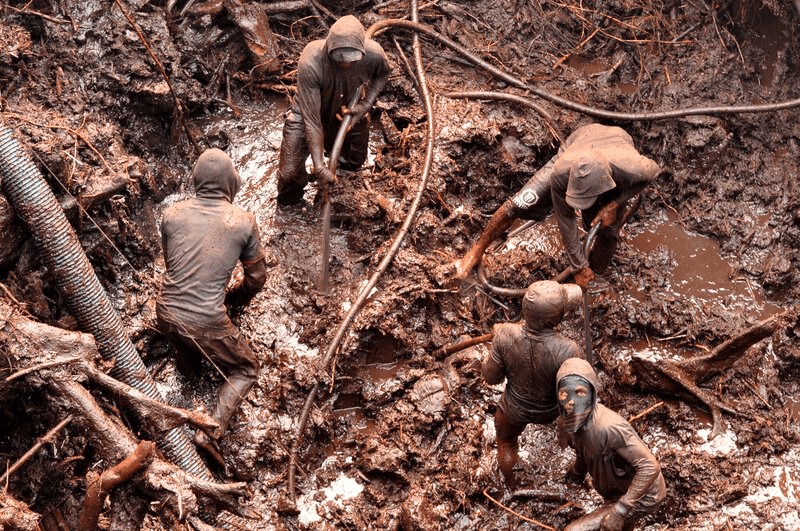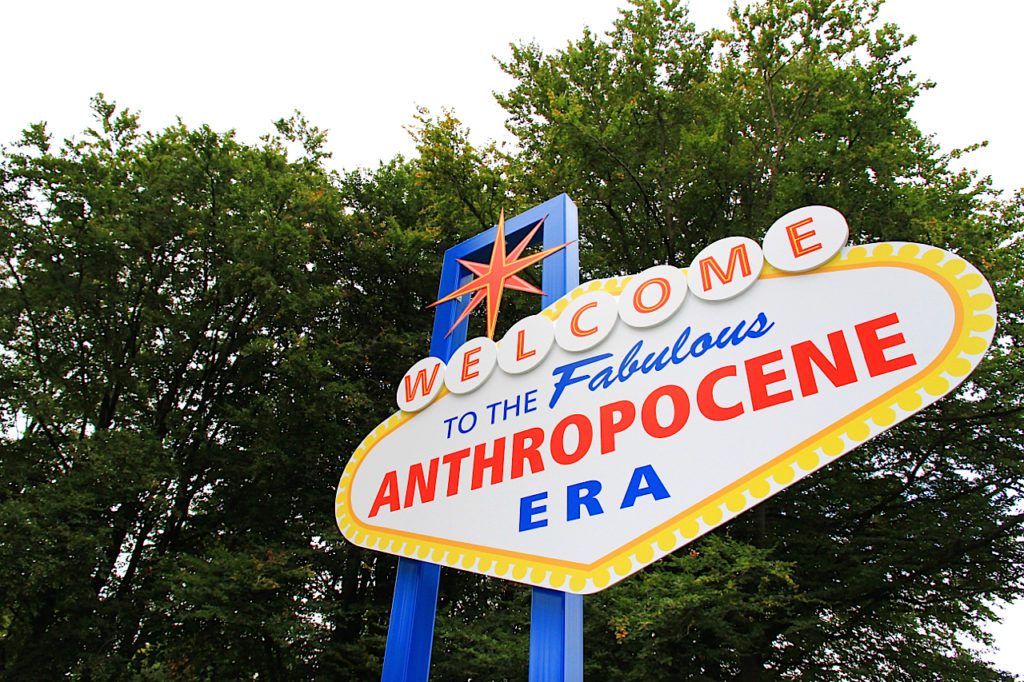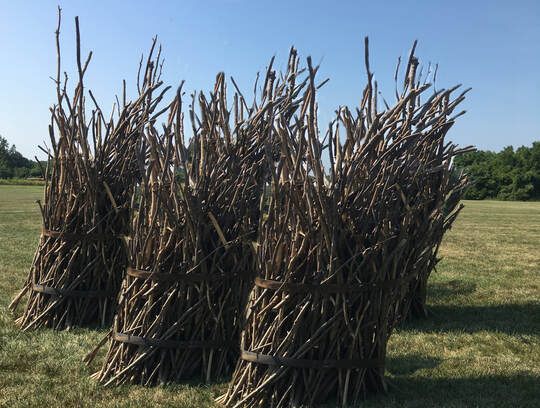INTRODUCTION

TOUCH SANITATION, Landfill (location and date unknown) photo: Deborah Freedman © Mierle Laderman Ukeles Courtesy the artist and Ronald Feldman Gallery, New York
EDITOR’S NOTE
Nearing the end of the Covid epidemic’s second year, we were wondering when normalcy might return, then the epiphany hit: ‘normal’ isn’t normal. Lives are lived in flux and adaptation. The personal challenge is to stay connected, empathetic, supportive of life in all its messy glorious diversity; and despite alarmist clouds, to remain politically and ecologically alert and active. Epidemics and extreme weather events are here, now. Creatives have vital roles to play: to pique imagination, stimulate collective genius, and formulate multiple road maps to reach new truths and cross-species survival. We all share this global, lifelong journey.
FEATURED ARTIST: MIERLE LADERMAN UKELES
With great respect and gratitude, WEAD honors ecoart pioneer Mierle Laderman Ukeles as ISSUE 12 Featured Artist. Amazingly, it was almost 50 years ago that Mierle reinvented herself as New York City Sanitation Department’s Artist in Residence (unsalaried, of course). In her essay she shares her ‘origin story.’ In the 1970’s, already a successful abstract painter and feminist, she gave birth to her first child. Motherhood led to an epiphany: it had permanently altered her life and career. Mothers are unpaid private maintenance workers–with unending burdens and cultural disrespect akin to those of the City’s public maintenance workers. To paraphrase critical writer Suzi Gablik: Mierle ‘developed interactive, ecological models to create art that is social and purposeful and rejects modernist myths of autonomy and neutrality.’ Mierle listened to others, and continues to listen today, forging a strong working model for subsequent generations of social/ecoartists to follow.
UNIQUE GLOBAL COLLABORATION

THE LOOK, small-scale gold mining laborers, Nancy Peluso, West Kalimantan, 2015.
EXTRACTION — ART ON THE EDGE OF THE ABYSS
ISSUE 12 is one of three WEAD contributions to Extraction: Art on the Edge of the Abyss. Conceived and produced by CODEX Foundation Director Peter Koch, Extraction is a unique multi-year, multimedia, multi-venue international art intervention to investigate the extraction industry in all its forms. ISSUE 12 illuminates women artists’ positive ‘actions’ to redress the scars of extraction. Two companion member exhibits entitled ART ON THE EDGE: From Extraction to Restoration and Regeneration were produced at Gallery Route One, Marin County CA and the Peninsula Museum of Art in San Bruno CA.
THE ESSAYS

HABITUS, Robyn Woolston, Edge Hill University Arts Centre Commission, Ormskirk, UK (2013)
LESLIE LABOWITZ INTERVIEWED BY JACKIE APPLE
In Los Angeles in the 70’s feminist performance artist Leslie Labowitz invented and collaborated on media events focusing on issues of violence against women. Active in the now-famous Women’s Building, in 1977-79 she collaborated with Suzanne Lacy to produce several important public performance events, including In Mourning and in Rage. They invented a model for media event as performance, attracting significant public attention to a feminist perspective in the news. Since 1980 she has been working with the metaphor of urban farming and healing through performance art. It eventually became a self-sustaining business. Jackie Apple, well known critic and chronicler of feminist performance art and the environment, interviews Leslie. They have been friends since the 70’s. This interview is both historical and educational for artists and activists.
EVGENIA EMETS 1000 Eternal Forest Sanctuaries for 1000 years
Evgenia is an artist and a poet working with forests, ecology, biodiversity and community through her visual works, poetry, installation, performance, film, artist’s books and large scale ecological artworks. Born in Russia, art educated in London, she moved to Portugal in 2017 where she has created poetry, art and interactive public events to increase awareness of the importance of biodiversity in reforestation.
EDIE DILLION Resource Colonialism, Historical Trauma, Art Intervention and Healing Between the Sacred Mountains.
Edie Dillion is an artist and writer who splits her time between studios Washington state and Arizona, In a deeply researched essay, she reports on the life threatening negative effects of first coal, and then, uranium mining on the health and lands of the Navajo Nation in Arizona.
ROBYN WOOLSTON Notes from the Precipice
Living and working in Scotland, Robyn describes herself as ‘a cultural worker who creates installations, films and site-responsive works.’
LAUREN ELDER Disappearing Hardwoods
Multimedia artist, stage designer Lauren Elder, uncovers the misuse of a precious resource–lauan wood. Lauren lives in Oakland CA and is a WEAD Board Member.
ZEA MORITZ MARY EUBANK and the Founding of Gallery Route One
Artist and writer Zea Moritz writes about Mary Eubank’s important contributions to the founding of Gallery Route One, a unique artists’ nonprofit gallery dedicated to environmental and social programming, situated in far west rural Marin County, CA.
COMMENTARY
MARY JO AAGERSTOUN White feminist art historian Mary Jo has produced several public community-based ecoart projects in Florida. In the midst of beginning to write a new book herself, she began her research by reading 5 books by black authors on the American black experience in landscape and ecoart. Here are her thoughts.
TERESA CAMOZZI Northern CA artist’s personal experience of Global warming and increasing dangers of CA fires. She embraces photo journalism as a new component in her professional artist photographer’s life.
ON MY MIND
RIA VANDEN EYNDE In an editorial essay entitled Shaping a Feminist Activist Painting Practice, this Belgian artist researches gender inequality and the difficulty of limiting ‘feminism’ to one definition. She begins by asking, ‘Which Feminism?’.
ARTISTS’ PORTFOLIO
The Portfolio is a mini on-line exhibit curated to spotlight WEAD members’ work on the Issue theme.
The Portfolio is an asset of WEAD membership to give artists the opportunity to share recent work. Join WEAD now! There’s an open call every issue, so send us a few high quality images with brief descriptions.

LAMENT, Steel, oak/maple/pine sticks (14’x14’x8′ ), Stephanie Garon. Women around the world, from Bangladesh to Benin, carry bundles of sticks to support their community. Confined by land and ritualistic roles, Lament references women’s work.
WELCOME to Jane Chin Davidson, Ph.d
One of our newest Board Members, Jane is Professor of Art History and Global Cultures at Cal State University San Bernardino, and a published author. She has joined WEAD Magazine’s Editorial Committee, and we very much look forward to working with her, and to learning from and sharing her expertise.
DEDICATION:
To lost friends Collectively brilliant, complex, ambitious (in the best sense), and ardent advocates of eco/social justice art. This issue is dedicated to esteemed colleagues who died in 2020-21.
AMY LIPTON (1956-2020) Gallerist, independent curator, writer and since 1999, ecoartspace’s East Coast co-director. In the 90’s she had her own NY gallery, introducing such artists as Mel Chin and Karen Finley. In 1996 her gallery closed, freeing her to work independently as ecoart activist curator. She worked on numerous groundbreaking exhibits, including the multi-artist exhibit and book ECOVISION, 2002, collaboration with Sue Spaid, the Contemporary Art Center, Cincinnati; and FOODshed: Agriculture and Art in Action, 2015, Smack Mellon Gallery, Brooklyn.
BONNIE SHERK (1945-2021) 50-year career as an American landscape planner, educator, international ecoartist and pioneer environmental performance artist. She was founder of The Crossroads Community, aka The Farm (San Francisco) and The Living Library –an ongoing series of interactive community teaching gardens.
MOIRA ROTH (1933-2021) Feminist art historian, published author, and art critic who was Trefethen Professor of Art History at Mills College, Oakland CA, 1985 to 2017. She received a Lifetime Achievement Award from the Women’s Caucus of the Arts, 1997, and the College Art Association’s National Recognition in the Arts Award, 2006. Author of many books and essays, she was known as an avid advocate of women’s art and women of color artists, performance art, and at Mills College, as a beloved mentor to students.
NEXT ISSUE
We are now accepting magazine essay proposals on an open, rolling basis for 2022 Magazine ISSUE 13. Email to info@weadartists.org, title: Magazine Proposal 2022
WEAD MAGAZINE ISSUE No. 12, TAKING ACTION
Published October 2021
